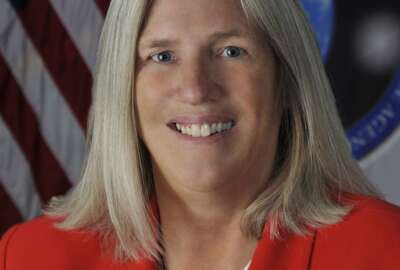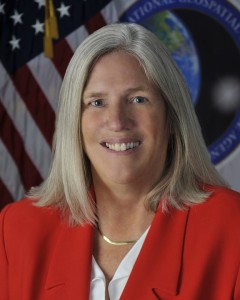
NGA heads to Silicon Valley with other digital pioneers
The National Geospatial Intelligence Agency is the latest federal agency to establish a permanent presence in Silicon Valley. Agencies are feeling the need to b...
Manifest destiny is making a comeback in the federal government. The 21st century version holds that expansion into digital spaces is inevitable. And just like in the 18th century, it’s inspiring pioneers to move west.
The National Geospatial Intelligence Agency is the latest federal agency to establish a permanent presence in Silicon Valley, the iconic hub of technological innovation. Sue Gordon, deputy director of the NGA, told the Federal Drive with Tom Temin that agencies are feeling the need to be closer to the innovators in order to feed off their energy, get involved in partnerships and stay on top of the cutting edge of innovation.

“The idea is to position us to be present with the innovators as they innovate, and have enough of our talent there, whether it’s analytic talent or technical talent, so we can discover together the possibilities of the offering and introduce them right into our mission space so that we deliver better geospatial intelligence, whether to the warfighter or to the policy maker,” Gordon said.
She said the NGA is going to be actively building partnerships with major players in the area, including Amazon, In-Q-Tel and universities.
“We’re not just going to hang up a shingle and hope people will come to us,” Gordon said. “We are going to position ourselves to be present where those partnerships are already happening.”
She said the initial team NGA sends west will consist of three to four people at first, and then expand to about a dozen. The team will consist of technologists, data scientists and analysts.
“What the analysts bring is the mission demand that makes some of these technical capabilities sing,” Gordon said. “So what we’re hoping is to put that energetic combination from the purpose end, our mission end, out there so we can make faster decisions with our external partners about what will work and what can be produced.”
In addition, Gordon expects the team to learn about marketing and delivery methods used in Silicon Valley. NGA has already made moves to change its architecture with GEOINT Services and revamp the way it delivers products to customers through the cloud. The system will allow NGA to deliver more capabilities faster. Gordon said speed is her metric for success.
“We simply have to be faster at taking advantage of the capabilities that can make a difference to our users,” she said.
Another change Gordon sees coming is to the current model of workforce development. She sees a need for more “flow-through” of inside and outside government, and less concentration in the geographical location of the workforce.
“Because we’re competing for the exact same people that industry needs, we’re going to have to do so in such a way that they don’t lose anything when they work with us,” Gordon said.
GEOINT is currently undergoing a revolution, where geospatial intelligence is no longer only relevant to warfighters and policy makers, but to the average citizen as well. Commercial imagery has increased not only the number of maps but the amount of content, Gordon said.
“That combination of those two spaces has led to a real rise in the technologies that take advantage of them, that can analyze image data, that can put that data into a geospatial framework,” she said. “So you just have that energy coming up out of the commercial need for it, and it’s dovetailing with our drive and our history to provide better and better intelligence for our customers.”
Gordon said that there is so much information being openly produced that is useful that the NGA is challenged in figuring out how to make use of it all. The agency is examining using commercial satellite imagery, social media and open street maps — any unclassified data that has reference to time and space — to help accomplish its mission. This program is called Pathfinder.
Pathfinder has allowed NGA to explore what kinds of unclassified data are available, and what kinds of tools are available to help examine that data.
“It’s allowed us to recognize that we have things to contribute to that community, whether through Github or in code that can make us a great citizen in this great stream of open GEOINT-ers,” Gordon said.
NGA is also considering the possibilities of citizen science in leveraging unclassified data.
“There are fascinating authoritative and legal challenges with doing that, but I do think that’s the direction we’ll move, and it has incredible potential for us,” she said.
But the main challenge, she said, is the accuracy of the data. In leveraging citizen scientists, NGA would be collecting massive amounts of data, too much to easily verify the accuracy of it all.
Despite the amount of unclassified data currently available, Gordon said the NGA will always have its own niche.
“There is still, and I expect there always will be, information that we require that either can’t or won’t be produced commercially,” she said. “It’s special. It is either so exquisite or so expensive or so unique that it doesn’t have the same commercial market.”
Gordon used the Nepal earthquake as an example. Everyone was providing data to help relief efforts, but NGA was the only organization that had such precise data that it knew the runway had moved.
“To me, we do have to recognize what is going to become openly available, and adjust what we spend our money on to take advantage of that, and only produce that which only we can produce,” she said.
Copyright © 2024 Federal News Network. All rights reserved. This website is not intended for users located within the European Economic Area.
Daisy Thornton is Federal News Network’s digital managing editor. In addition to her editing responsibilities, she covers federal management, workforce and technology issues. She is also the commentary editor; email her your letters to the editor and pitches for contributed bylines.
Follow @dthorntonWFED




